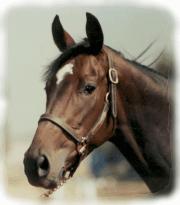A Horse, of Course with Don Blazer |
If you enjoy learning about horses, then you'll love our online courses. Each month you'll find a new column on our web site. We hope you'll enjoy it, and maybe e-mail us with questions or suggestions for other columns. A Horse, Of Course is a monthly column syndicated by Success Is Easy. If you like the column, call your local newspaper, or local horse publication and ask them to subscribe by contacting Success Is Easy. |
Lame Horse? Don Blazer copyright©2011 The more we know, the more complicated things become. In the “old days” a horse was lame, or he wasn’t lame. Today a horse is or is not, “suitable for the purpose intended.” I think that is a good thing. I’m not as good as I once was…but I’m still not bad if you choose the right “intended purpose.” So, there’s no need to shoot me…yet! Seeing that a horse is lame (detection of lameness) can be relatively easy, while the diagnosis of lameness (knowing where and why) is often complicated, unless evident in an open wound, obvious swelling, heat or joint pain. Slight lameness, especially in the hindquarters, is often best detected when the horse is in a stall. When turning his forehand from side to side, the horse with a spavin or stringhalt will shift his weight onto one hind leg more quickly than to the other, which may be considered the unsound limb. If the lameness is in the forehand, the horse will be reluctant to shift his weight onto the affected limb when asked to move side to side. A horse “off” in the forehand will often “point” the affected limb. It is not uncommon for a horse to have one foot slightly advanced when standing quietly; however, if the horse is sound, both front feet will assume equal weight. (Unless, of course, he is equally unsound in both front legs, in which case he’ll most often stand squarely….see how complicated things can get.) If the horse is pointing, then the affected limb will be rested only on the toe, heel, or, if kept flat, will not bear weight. A horse lame in one front foot usually stands with the pastern straighter than that of the sound leg. When examining a horse in movement, it is best to trot the horse. The trot is a diagonal two-beat gait, with only two feet grounded at the same time; therefore each leg bears more weight than at the walk. When trotting, a horse will favor the unsound limb at the expense of its sound diagonal. A lame horse uses his head and neck for balance and to relieve weight on the unsound limb, so he’ll raise his head when the lame front leg strikes the ground. Conversely, he lowers his head when the sound limb strikes the ground. This is called “head-nodding lame.” It is usually easy to see at the trot, and much more difficult to detect at the walk. If a horse is lame behind on the right, he will lower his head when the left forefoot is placed on the ground. If you suspect a horse may be off behind, view him from behind as he trots. If lame, he’ll hitch up the unsound quarter in an attempt to keep weight off that side. Other signs of hind leg lameness are the dwelling on one foot longer than the other, or the higher lifting of one foot, or the dragging of the toe on the unsound foot. A horse with pain in both front limbs, or both fronts and both backs, will travel short and stiff and will lack freedom in placing his feet. When a horse is lame, and there is no other “obvious reason,” check his feet! In most cases the cause of the lameness will be found in the feet. If the direct cause is not found in the feet, the chances are still good a contributing cause is there. If you can’t determine the cause of the lameness yourself, then a call to a veterinarian is in order. But don’t expect the vet to be “all knowing.” While most vets have “diagnostic” tools that you don’t keep handy---especial drugs to block sections of the leg and hoof—the exact where and why, as mentioned before, can be very tricky. Once you think the lameness has been detected, the veterinarian will have suggestions for treatment. But treatment can be very frustrating. The lameness doesn’t always go away immediately. The first treatment rule I like to go by is: “if it hurts to do that, don’t do that.” So if it hurts your horse to do that, then keep your horse from doing that. That treatment is also known as a “tincture of time.” |
